Virtual Spaces for Exhibiting Digital Artworks: Exploration of interactions and space (un)familiarity
Author: Borko Hadjievski
Published on: 17.09.2022
Many art institutions encompass the use of technology (2D, 3D, photogrammetry, etc.) for online virtual exhibitions of existing artworks and artefacts. Those virtual exhibitions serve complementary functions to the physical artworks and artefacts in the museums, allowing people to explore the existing collections from their homes and view additional information in an interactive format. Yet, the existing practice provides for a very limited interaction of audiences with digital artworks. In my master’s research I propose a design of virtual exhibition spaces for interactive digital artworks that are impossible to exist and exhibit in a physical space, including artworks that defy the laws of physics (e.g., floating in space, changing shape) or are too difficult to execute in terms of cost or space availability. I also explore the space familiarity in a virtual environment and how it connects to the identity of art institutions, meaning virtually replicating existing spaces that visitors can recognise. I am exploring these topics through the appropriation of game design software in combination with architectural software.
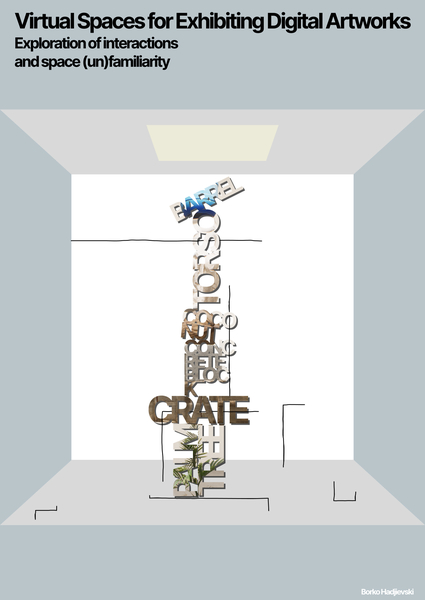
Poster for the work “Make your own God”
I have partnered with PrivatePrint Studio and artist Ilija Prokopiev who has provided his work-in-progress “Make your own God” as the basis for my exploration. In this digital art installation, Prokopiev explores the similarities between the creation of gods and what he calls today’s virtual logic. Just like the images and sculptures of gods and godlike beings, especially in the pre-Christian period, consisted of different parts of humans, animals, plants, in this virtual exhibition space, the artist places several different objects, scattered around the floor. These objects are meant to be used by the audience to create a new godlike being, a ‘sacred’ personalised totem, by stacking the objects on a platform in the middle of the space, therefore creating their own spirit being, their God. For the interaction with the objects, together with the artist, it was decided that the primary mechanics will be ‘picking up’ and ‘stacking’ the objects.
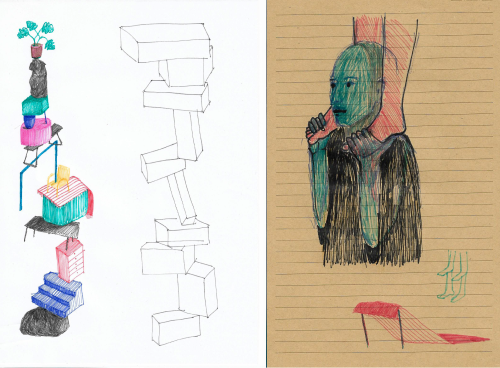
Ilija Prokopiev, Sketches for the work “Make your own God”
Much like how museums build extensions of their buildings for exhibiting new art, i.e. Tate Museum’s Switch House that allows for exhibitions of large-scale art installations, I have designed two virtual spaces for exhibiting the digital artwork. The first space is a virtual replica of the Private Print Gallery and the second a fictional exhibition space with similar parameters (following the ‘White Cube’ model). This allowed me to explore how the audience experiences the interactive digital artwork in both familiar (that is representative of the institutions’ physical space) and unfamiliar virtual spaces, which connects differently to the identity of the art institution.
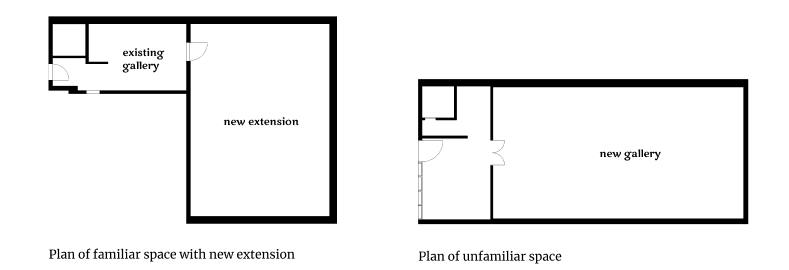
Floorplans of the two virtual exhibition spaces
I have conducted playtests during which I asked playtesters to create an art piece, a totem, by stacking random objects. The playtests were followed by interviews to understand experiences with the interactive artwork, and the familiar and unfamiliar spaces.
The results show that the familiarity of the space has a positive impact on the visitors, since positive memories and associations with the space make them more receptive towards interaction with digital art. All of the playtesters preferred the familiar space and found it to be better than the unfamiliar, even if the differences were minute. Although heavily criticised, the ‘White Cube’ (Herbert, 2021) concept in the case of the PrivatePrint gallery was followed to help forge a connection to the memory of the existing space. This means that the familiarity of the space, together with the affordance of virtual space free from physical constraints, enables the creation of a variety of playful interactions, which come together as ‘experiential wholes’ (Wiltse & Stolterman, 2010).
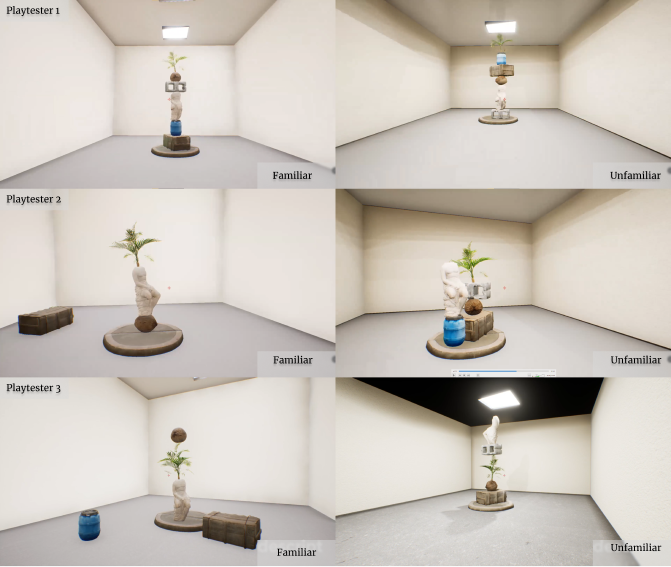
Images of the playtests
Moreover, the playtesting results indicate a positive experience of the game mechanics. The playful nature of the exhibition was praised as enjoyable and fun. With this artwork, by using architectural and gaming software it became possible to use simple mechanics, but still afford rich interactions. When picking up, dropping, rotating and stacking the objects, the positive changes in behaviour of the playtesters was clearly evident. I found that giving playtesters the freedom to play with the objects, became a crucial element of the exhibition. Playfulness was indeed an attitude (Sicart, 2014), as was the rule-breaking (Dissanayake, 1974) when playtesters found a way to get the objects stuck into the walls. When interactions of this kind are designed to be ambiguous, they open up for appropriation (Höök, 2006) and begin to offer memorable experiences to users.
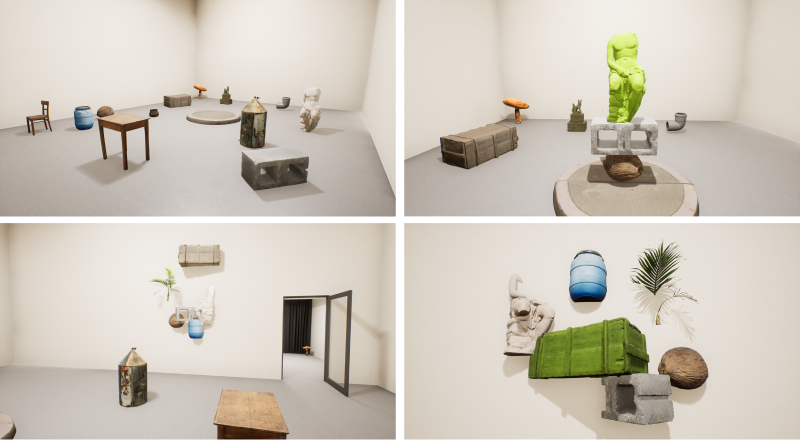
Final Proposal for the exhibition “Make your own God”
My design approach contends that digital technology should adopt playfulness, which derives from play. Interactive art is an event which is not finalised, but conditions are created for playful interaction. In the context of digital interactive art, game mechanics are the afforded actions which enable the interaction, that is the creation of the artwork event. The virtual space, the game mechanics and the artwork together should come as an ‘experiential whole’, telling a unified story.
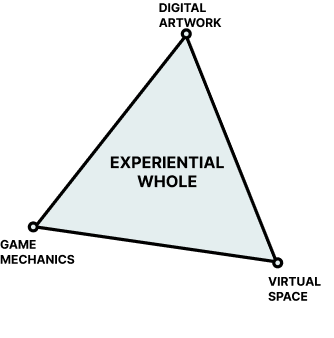
Diagram of the concept of ‘experiential whole’
My design proposal encourages the exploration and creation of playful interactions in virtual exhibitions, that can be further developed by other designers to enhance the connection with digital art, and create stronger ties between art institutions and visitors. Expanding into the digital realm where most of us now dwell, interactive art can become a larger part of our lives, allowing us to admire and create art, free from physical constrains.
\\
Borko Hadjievski is an architect and interaction designer who initiated the PrivatePrint VR Studio. He has an international work experience in architecture, but also VR, visualisation and digital design. He is a proficient user of various 2d, 3d design and rendering software. He holds an MSc in Interaction Design from Malmö University, Sweden and a BSc in Architecture from the Faculty of Architecture, Skopje. He currently works and lives in Lund, Sweden.
This blog summarises his master thesis completed at Malmö University in June 2022, which can be accessed on the following LINK
Supervisor: Prof. Simon Niedenthal
Art concept: Ilija Prokopiev
Mechanics blueprints: Mario Marquardt
\\
References:
Dissanayake, E. (1974). A hypothesis of the evolution of art from play. Leonardo, 7(3), 211-217.
Herbert, M. (2021, January 21). What the ‘White Cube’ Means Now.. ArtReview. https://artreview.com/what-the-white-cube-means-now/
Höök, K. (2006, October). Designing familiar open surfaces. In Proceedings of the 4th Nordic conference on Human-computer interaction: changing roles (pp. 242-251).
Sicart, M. (2014). Play matters. mit Press.
Wiltse, H., & Stolterman, E. (2010, October). Architectures of interaction: An architectural perspective on digital experience. In Proceedings of the 6th Nordic Conference on Human-Computer Interaction: Extending Boundaries (pp. 821-824).
\\
VR Studio 2022 is co-financed by the Ministry of Culture of the Republic of North Macedonia and made possible through our activities in the PrivatePrint Meets series funded by the Prince Claus Network Partnership Programme.